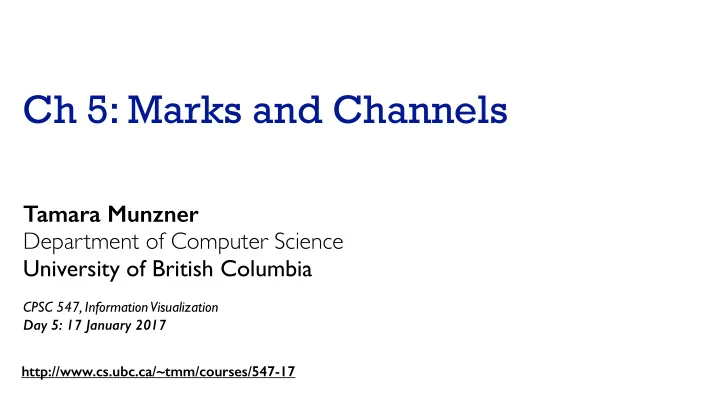

Ch 5: Marks and Channels Tamara Munzner Department of Computer Science University of British Columbia CPSC 547, Information Visualization Day 5: 17 January 2017 http://www.cs.ubc.ca/~tmm/courses/547-17
News • comments marks out for 3/Tasks and 4/Validation, – lect 2 avg 86, min 73, max 94 – lect 3 avg 85, min 78, max 98 – lect 4 avg 88, min 84, max 100 2
Now • first, work in small groups – exercise: decoding marks and channels – 45 min, +/- 15 min • status checkins at 30 min, 45 min, (60 min) • then readings discussion 3
VAD Ch 5: Marks and Channels Channels: Expressiveness Types and E fg ectiveness Ranks Magnitude Channels: Ordered Attributes Identity Channels: Categorical Attributes Position on common scale Spatial region Position on unaligned scale Color hue Length (1D size) Motion Tilt/angle Shape Area (2D size) Depth (3D position) Color luminance Color saturation Curvature Volume (3D size) [VAD Fig 5.1] 4
Encoding visually • analyze idiom structure 5
Definitions: Marks and channels • marks Points Lines Areas – geometric primitives Position Color • channels Horizontal Vertical Both – control appearance of marks Shape Tilt Size Length Area Volume 6
Encoding visually with marks and channels • analyze idiom structure – as combination of marks and channels 1: 2: 3: 4: vertical position vertical position vertical position vertical position horizontal position horizontal position horizontal position color hue color hue size (area) mark: line mark: point mark: point mark: point 7
Channels: Expressiveness types and effectiveness rankings Magnitude Channels: Ordered Attributes Identity Channels: Categorical Attributes Position on common scale Spatial region Position on unaligned scale Color hue Length (1D size) Motion Tilt/angle Shape Area (2D size) Depth (3D position) Color luminance Color saturation Curvature Volume (3D size) 8
Channels: Rankings Magnitude Channels: Ordered Attributes Identity Channels: Categorical Attributes Position on common scale Spatial region Position on unaligned scale Color hue Length (1D size) Motion Tilt/angle Shape Area (2D size) • effectiveness principle Depth (3D position) – encode most important attributes with highest ranked channels Color luminance • expressiveness principle Color saturation – match channel and data characteristics Curvature Volume (3D size) 9
Grouping Marks as Links Containment Connection • containment • connection Identity Channels: Categorical Attributes • proximity Spatial region – same spatial region Color hue • similarity – same values as other Motion categorical channels Shape 10
Accuracy: Fundamental Theory 11
Accuracy: Vis experiments Cleveland & McGill’s Results Positions 1.0 1.5 2.0 2.5 3.0 Log Error Crowdsourced Results Angles Circular [Crowdsourcing Graphical areas Perception: Using Mechanical Turk to Assess Visualization Design. Rectangular areas Heer and Bostock. Proc ACM Conf. (aligned or in a Human Factors in Computing treemap) Systems (CHI) 2010, p. 203– 212.] 1.0 1.5 2.0 2.5 3.0 12 after Michael McGuffin course slides, http://profs.etsmtl.ca/mmcguffin/ Log Error
Discriminability: How many usable steps? • must be sufficient for number of attribute levels to show – linewidth: few bins [mappa.mundi.net/maps/maps 014/telegeography.html] 13
Separability vs. Integrality Position Size Width Red Hue (Color) Hue (Color) Height Green Fully separable Some interference Some/signi fj cant Major interference interference 2 groups each 2 groups each 3 groups total: 4 groups total: integral area integral hue 14
Further reading: Articles • Perception in Vision web page with demos, Christopher Healey. (see also Attention and Visual Memory in Visualization and Computer Graphics, Christopher G. Healey and James T. Enns, IEEE TVCG 18(7):1170-1188 2012.) • Crowdsourcing Graphical Perception: Using Mechanical Turk to Assess Visualization Design . Jeffrey Heer and Michael Bostock. Proc. CHI 2010 • Graphical Perception: Theory, Experimentation and the Application to the Development of Graphical Models . William S. Cleveland, Robert McGill, J. Am. Stat. Assoc. 79:387, pp. 531-554, 1984. • A Model for Studying Display Methods of Statistical Graphics (with Discussion). William S. Cleveland. Journal of Computational and Statistical Graphics 2(4):323-364 1993. • Automating the Design of Graphical Presentations of Relational Information . Jock Mackinlay, ACM Transaction on Graphics, vol. 5, no. 2, April 1986, pp. 110-141. • Taxonomy-Based Glyph Design---With a Case Study on Visualizing Workflows of Biological Experiments . Eamonn Maguire, Philippe Rocca-Serra, Susanna-Assunta Sansone, Jim Davies, and Min Chen. IEEE TVCG (Proc. InfoVis 12) 18(12):2603-2612 2012. • Glyph-Based Visualization: Foundations, Design Guidelines, Techniques and Applications . Rita Borgo, Johannes Kehrer, David H.S. Chung, Eamonn Maguire, Robert S. Laramee, Helwig Hauser, Matthew Ward, and Min Chen. Eurographics State of the Art Reports (STAR):39-63 2013. • On the Theory of Scales of Measurement . S. S. Stevens. Science 103(2684):677-680, 1946. • Feature Analysis in Early Vision: Evidence from Search Asymmetries. Treisman and Gormican. Psychological Review 95(1): 15-48, 1988. 15
Further reading: Books • Visualization Analysis and Design. Munzner. CRC Press, 2014. – Chap 5: Marks and Channels • Visual Thinking for Design. Ware. Morgan Kaufmann, 2008. • Information Visualization: Perception for Design, 3rd edition. Ware. Morgan Kaufmann /Academic Press, 2013. • How Maps Work: Representation, Visualization, and Design. Alan M. MacEachren. Guilford Press, 1995. • The Grammar of Graphics, Leland Wilkinson, Springer-Verlag 1999. • Semiology of Graphics, Jacques Bertin, Gauthier-Villars 1967, EHESS 1998. • Psychophysics: Introduction to its Perceptual, Neural, and Social Prospects. Stevens. Wiley, 1975. 16
Next Time • to read – VAD Ch. 6: Rules of Thumb – paper: Artery Viz (type: design study / evaluation) • reminder: office hrs after class today 17
Recommend
More recommend